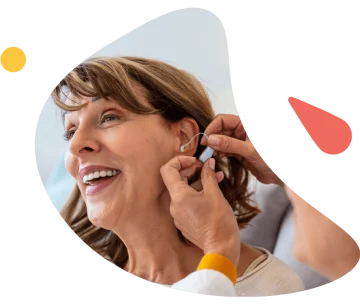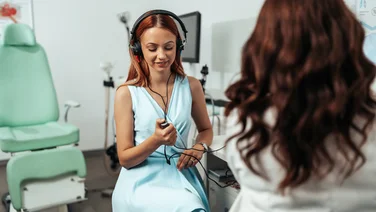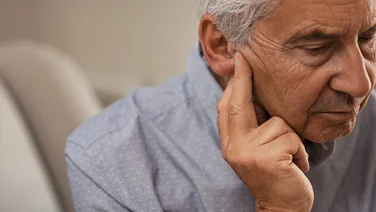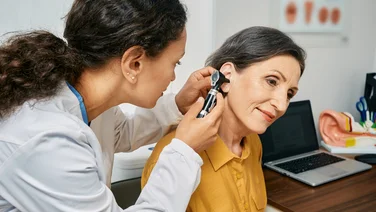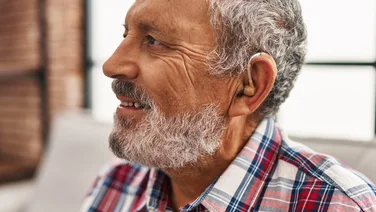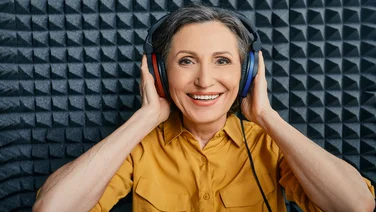Our content is funded in part by commercial partnerships, at no extra cost to you and without impact to our editorial impartiality.
Most people have experienced barotrauma to the ears and probably don’t even know it.
It might sound serious, but it’s a common, usually harmless, everyday occurrence.
If you’ve ever wondered how to ‘pop’ your ears or how to stop your ears from ‘popping’, then you’ll certainly be familiar with barotrauma.
Ear barotrauma is the medical term for damage to ear tissues caused by the difference between the air pressure inside your ears and the air pressure around you. It causes your hearing to dip out or become muffled and your ears to feel clogged up.Remember, if your hearing is starting to bother you, or is gradually getting worse, it’s always worth speaking to a professional. We can connect you with a local audiologist to get you the help you need. Fill in our quick form and we’ll do the rest.
Why does my ear feel clogged?
Ear barotrauma occurs when there is a difference between air pressure inside and outside the body, causing your ears to feel clogged. To understand why it happens, it helps to know a bit about the structures of the ear. Take a look at the diagram below:

The ear is made up of three main parts: the outer ear, middle ear, and inner ear.
The eardrum, or tympanic membrane, is a small, thin, cone-shaped tissue that separates the outer ear from the middle ear.
Either side of the eardrum is a cavity that’s filled with air.
Towards the outside is the ear canal, which allows sound to enter the middle ear and pass through the inner ear to the brain.
Towards the inside is a space called the tympanic cavity, which is connected to the upper part of the throat at the back of the nose by a channel called the eustachian tube.
The air inside the ear canal, the tympanic cavity, and the eustachian tube should be at equal pressure to allow the eardrum to function normally.
If the pressure outside the ear suddenly changes, it places tension on the eardrum, stretching it and pushing it inwards. As well as causing pain and discomfort, the stretched eardrum can’t vibrate properly to send sound waves to the inner ear and brain.
As a result, you experience hearing loss, or your hearing becomes muffled. You might also feel like your ears are clogged, as if you’re wearing earplugs.
Why does ear barotrauma happen?
It’s common to experience ear barotrauma during a flight, usually during takeoff or landing. You may experience a sensation of fullness or clogging in your ears, and is usually accompanied by difficulty hearing. You may also feel the need to ‘pop’ your ears.
This is caused by a change in altitude. As the altitude rises, the air pressure in the atmosphere drops, and vice versa.
When the plane begins to descend from high altitude, the air pressure inside the cabin rises. In turn, the air pressure in the ear canal also changes, but the pressure of the air in the eustachian tube remains the same.
It can happen in any situation that involves going to high or low altitudes relatively quickly, like riding up to the top of a very tall building in an elevator, driving up a mountain, or diving into deep water.
You might also feel like you need to ‘pop’ your ears when you have a cold. This is because a runny or stuffy nose can block the eustachian tube, stopping mucus from taking its usual path along the eustachian tube to the throat, causing an imbalance of pressure.
The same thing can happen if you get an ear infection. The eustachian tube becomes irritated and inflamed, allowing fluid to build up in the middle ear, preventing the eustachian tube from equalizing the pressure.
That’s why you sometimes feel the need to ‘pop’ your ears after an ear infection.
How do you relieve ear pressure?
Some people refer to this pressure change and the problems it causes as their ear ‘popping’, while others use the term ‘popping’ to describe fixing the problem.
Either way, the air pressure on either side of the eardrum needs to equalize for your hearing to return to normal, and for the pain and clogged feeling to ease.
This means the eustachian tube, which is normally closed (except for when you chew, yawn and swallow), has to open and allow air to travel up and into the middle ear.
How to ‘pop’ your ears without it hurting
There are several tried-and-trusted methods to get your ears to safely ‘pop’ if you’re experiencing the symptoms of ear barotrauma.
The first things to try are: swallowing, yawning, or sucking a piece of candy. These actions open up the eustachian tube, helping the air to flow, equalizing the pressure in the middle ear.
One method you’ll likely have tried is to forcibly ‘pop’ your ears by attempting to blow air out of your mouth while pinching your nose. This is called the Valsalva maneuver.
- Take a breath in, hold your breath, and close your mouth
- Pinch your nostrils closed
- Try to blow air through your nose
- Do this for 10 to 15 seconds, before releasing your breath
You won’t be able to force the air out because, with your mouth and nostrils closed, there is no route for the air to escape. This causes pressure at the back of the nose, which can prompt the eustachian tube to open and equalize the pressure.
You might feel your ears ‘pop’. If not, you should notice your ears begin to unclog and your hearing will gradually return as the air pressure normalizes.
‘Popping’ your ears this way is generally safe – and a small study of different methods of opening the eustachian tube found the Valsalva maneuver to be the most effective.
But you should use it with caution: it’s important you don’t force your breath or blow too hard because it can cause too much pressure and create a hole in your eardrum.
Avoid the maneuver if you have a cold or any discharge from your nose because it can move bacteria and infected mucus into the ear canal or middle ear, resulting in an ear infection.
What are other methods for popping ears?
A method similar to the Valsalva maneuver is the Toynbee maneuver. With this method, you pinch your nostrils closed and swallow repeatedly until your ears ‘pop’. If you find it difficult to swallow on demand, try taking sips of water to help you swallow.
An alternatives is a decongestant, which is available as a nasal spray and in tablet form. These can help if you know you might experience the symptoms of ear barotrauma, such as when you’re due to fly.
An inexpensive way to avoid your ears feeling clogged during a flight is by chewing gum during the take off and landing.
Some people use special ear plugs that are designed to regulate air pressure. There is little evidence of their efficacy, but they may help to stop the quick air pressure change.
If not, they may still be useful to block out the noise on a flight, masking the effects of altitude change on your ears.
Experiencing hearing loss?
Book a free appointment with an audiologist to understand your options
